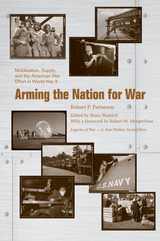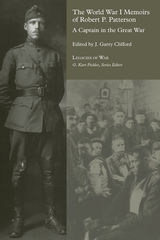
needs of soldiers on the battlefield. He was thus dismayed by America’s lack of military
preparedness when a second great war engulfed Europe in 1939–40. With the international
crisis worsening, Patterson even resumed military training—as a forty-nine-yearold
private—before being named assistant secretary of war in July 1940. That appointment
set the stage for Patterson’s central role in the country’s massive mobilization and
supply effort which helped the Allies win World War II.
In Arming the Nation for War, a previously unpublished account long buried among
the late author’s papers and originally marked confidential, Patterson describes the vast
challenges the United States faced as it had to equip, in a desperately short time, a fighting
force capable of confronting a formidable enemy. Brimming with data and detail, the book
also abounds with deep insights into the myriad problems encountered on the domestic
mobilization front—including the sometimes divergent interests of wartime planners and
industrial leaders—along with the logistical difficulties of supplying far-flung theaters of
war with everything from ships, planes, and tanks to food and medicine. Determined to
remind his contemporaries of how narrow the Allied margin of victory was and that the
war’s lessons not be forgotten, Patterson clearly intended the manuscript (which he wrote
between 1945 and ’47, when he was President Truman’s secretary of war) to contribute
to the postwar debates on the future of the military establishment. That passage of the
National Security Act of 1947, to which Patterson was a key contributor, answered many of
his concerns may explain why he never published the book during his lifetime.
A unique document offering an insider’s view of a watershed historical moment, Patterson’s
text is complemented by editor Brian Waddell’s extensive introduction and notes.
In addition, Robert M. Morgenthau, former Manhattan district attorney and a protégé of
Patterson’s for four years prior to the latter’s death in a 1952 plane crash, offers a heartfelt
remembrance of a man the New York Herald-Tribune called “an example of the public-spirited
citizen.”

“This memoir illuminates key aspects of the war experience: the enthusiasm for fighting, tensions with officers, tedium with regard to noncombatant work, the variety of trench experiences, the sharp learning curve that the army underwent on the ground, and the confusing nature of combat for ground troops. As the centennial of the war approaches this well-annotated memoir that connects Patterson’s individual experiences to the larger U.S. experience of the war will appeal to general readers and specialists alike.” —Jennifer D. Keene, author of World War I: The American Soldier Experience
A journalist once called Under Secretary of War Robert P. Patterson “the toughest man in Washington” for his fervid efforts in managing U.S. mobilization in World War II. The World War I Memoirs of Robert P. Patterson: A Captain in the Great War recounts Patterson’s own formative military experiences in the First World War.
Written in the years following the conflict, this is a remarkable rendering of what it was like to be an infantry line officer during the so-called Great War. Patterson started his military career as a twenty-seven-year-old, barely-trained captain in the American Expeditionary Forces (A.E.F.). He was part of the 306th Infantry Regiment of New York’s famous 77th “Statue of Liberty” Division from July to November 1918. In this detailed account, Patterson describes in understated yet vivid prose just how raw and unprepared American soldiers were for the titanic battles on the Western Front. Patterson downplays his near-death experience in a fierce firefight that earned him and several of his men from Company F the Distinguished Service Cross. His depiction of the brutal Meuse-Argonne battle is haunting—the drenching cold rains, the omnipresent barbed wire, deep fog-filled ravines, the sweet stench of mustard gas, chattering German machine-guns, crashing artillery shells, and even a rare hot meal to be savored.
Dealing with more than just combat, Patterson writes of the friendships and camaraderie among the officers and soldiers of different ethnic and class backgrounds who made up the “melting pot division” of the 77th. He betrays little of the postwar disillusionment that afflicted some members of the “Lost Generation.”Editor J. Garry Clifford’s introduction places Patterson and his actions in historical context and illuminates how Patterson applied lessons learned from the GreatWar to his later service as assistant secretary, under secretary, and secretary of war from 1940 to 1947.
READERS
Browse our collection.
PUBLISHERS
See BiblioVault's publisher services.
STUDENT SERVICES
Files for college accessibility offices.
UChicago Accessibility Resources
home | accessibility | search | about | contact us
BiblioVault ® 2001 - 2024
The University of Chicago Press









